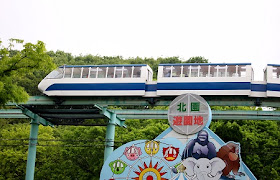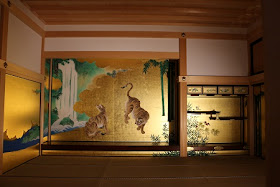I visited Higashiyama Zoo to see biological impacts of Fukushima No.1 nuclear power plant accident. Though I have visited various places in Japan to see the health consequences of the accident, I have never found any effect against creatures in Japan.
Higashiyama Zoo is located in Nagoya city, Aichi prefecture.
This zoo is a comprehensive park consisting of a zoo, botanical gardens and amusement park. Koalas, giraffes, and elephants are very popular animals here.
With its proud claim as being one of the largest zoos in Asia, the Higashiyama Zoo is home to approximately 570 species of animals. At the Botanical Gardens, famous for its tropical plants, one can enjoy the flowers of the four seasons.
Generally speaking, animal's growths are so fast than human beings that they are more sensitive to radioactive materials of the environment than us.
So I visited Higashiyama Zoo to see effects of the accident against creatures which are grown up by Japanese food and water. Fortunately, I could see them grown up safely and I couldn't find any impact of the Fukushima nuclear power plant accident. It seems that there is no problem for childbirth and child-rearing in Nagoya.
Posted by Yoshitaka Kiriake from Japan on June 20, 2014.
愛知県名古屋市にある東山動植物園は動物園の他、植物園、遊園地、東山スカイタワーが併設されており、敷地が広大で、とても一日では見て回れません。孵化したばかりのエミューを見ることが出来ました。2014年5月撮影。
Koala
コアラ
Higashiyama Zoo and Botanical Gardens
Google map
東山動植物園
Koala
コアラ
Red Kangaroo
アカカンガルー
Sumatran Tiger
スマトラトラ
Honey Badger, Ratel
ラーテル
Snow Leopard
ユキヒョウ
Jaguar
ジャガー
Polar Bear
ホッキョクグマ
Spectacled Bear
メガネグマ
Japanese Black Bear
ニッポンツキノワグマ
Malayan Sun Bear
マレーグマ
Small-clawed otter
コツメカワウソ
Great Indian Rhinoceros
インドサイ
Reticulated Giraffe
アミメキリン
Humboldt Penguin
フンボルトペンギン
California sea lion
カリフォルニアアシカ
Black Swan
ブラックスワン
Emu
They were born on April, 2014
エミュー
Little Egret
コサギ
Mandarin duck
オシドリ
African spoonbill
アフリカヘラサギ
Caribbean Flamingo
ベニイロフラミンゴ
Nagoya Castle
Nagoya Castle was constructed on the orders of Ieyasu TOKUGAWA in order to secure an important position on the Tokaido road and to ward off attacks from the direction of Osaka. Construction was completed in 1612, and the castle is typical of those built on flatlands.
English leaflet (PDF:2.4MB)
Google map
Nagoya Castle
There are golden dolphins on the roof.
名古屋城
The famous "Golden dolphins" on the roof are mythical sea creatures.
Nagoya Castle Hommaru Palace
The garden is full of flowers.
Japanese foods are good and safe.
Because of stricter food safety law by Japanese government, we have no worry about foods.
Sushi
Oden : Japanese pot-au-feu
Kishimen : "Kishimen" is similar to "Udon" but the noodles are flat compared with Udon.
Hitumabushi : Hitsumabushi is a tasty dish of chopped grilled eel on a bed of rice.
Fortunately I have never found any impacts by the accident among Japanese creatures. As far as I know, nobody has health problem which is caused by the accident in Japan.
Our Prime Minister Abe assures that "The situation is under control. The influence of the contaminated water is completely blocked within Fukushima. There are no health-related problems until now and there will never be health problems." He also said that "Tokyo is 250 kilometers away from Fukushima, and the kind of danger that you imagine does not exist in Tokyo. Tokyo is a very safe city."
As PM Abe said, Nagoya is very far away from Fukushima, people in Nagoya have no concern about the nuclear power plant accident. People in Nagoya have already forgotten the accident, because they think radioactive materials cannot reach there.
We know there is no problem for child birth and child rearing in Nagoya too. So people in Nagoya are living without any concern about the accident. I continue to visit various places in Japan to see the effects of the accident, because I can meet various creatures which are more sensitive to radioactive materials from the environment. It is important to see their health for our safety.
公衆衛生ネットワーク
Public Health Network in Japan




































0 件のコメント:
コメントを投稿